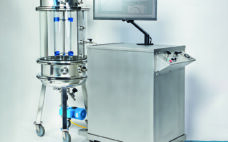In bioreactors, microorganisms or cell cultures produce complex therapeutic proteins and other biopharmaceuticals. The industrial production of those active pharmaceutical ingredients usually involves a seed train: the cells are run through many cultivation systems, which become larger with each passage (Upstream Process). An adequate number of cells for the inoculation of large-scale production bioreactors of 10,000 liters or more is generated. A prominent example from the growing mammalian cell culture processing sector is the upstream production process of monoclonal antibodies.…
Upstream
Optimizing Feed Strategies with Cellvento® ModiFeed Prime Comp: A Scalable Process
Development of upstream processes, that maximize productivity without increasing complexity, relies on the right combination of medium and feed and the ability to maintain tight control of culture conditions. In fed-batch mode, cells are initially grown in a relatively lean production medium followed by regular feed supplementation to achieve the desired product yield. This App Note presents an optimized feeding strategy and demonstrates how a new, easy-to-hydrate, single-part, pH neutral feed can support optimal cell growth and high productivity of…
Intensifying Upstream Processing and the Implications for Media Management
Process intensification offers many benefits but implementing PI can introduce an unexpected challenge of managing larger media volumes. This whitepaper covers the implications of media management when developing PI strategies. Key Learning Objectives: Gain the tools and knowledge needed to confidently assess intensification options with a focus on media management for new or existing facilities. Follow the media journey from prep to use, exploring potential logistical pitfalls in the management of increased media volumes associated with process intensification. See how…
3M™ Harvest RC Chromatographic Clarifier Beta Testing Series Summary
Frost & Sullivan invited a panel of industry leaders and key opinion leaders in pharmaceutical bioprocessing to participate in a new and unique thought leadership forum, our Virtual Think Tank (VTT) Early Access series. Each VTT panel, comprising professionals from pharmaceutical companies, contract development and manufacturing organizations (CDMOs), and 3M Company, discussed the new 3M™ Harvest RC Chromatographic clarification technology following participation in a beta test program that allowed them early access to work with the product and provide hands-on…
The Production and Application of Antibody Fragments
Antibodies are modular defense systems that identify and neutralize foreign objects like bacteria and viruses. In addition to oncology and inflammation, antibodies are now recognized as routine molecules in many therapeutic fields. Antibody fragments, in particular the Fabs, scFvs and VHH retain full antigen-binding capacity and superior properties for research, diagnostic and therapeutic applications. They have a smaller size that enables their binding to hidden epitopes not accessible to whole antibodies. In the context of therapeutic applications, a small molecular…
Human Umbilical Cord-derived Mesenchymal Stem Cell Production in Corning® HYPERStack® 36-layer Cell Culture Vessels
As more clinical trials are evaluating MSC-based therapies, the demand for more pertinent adherent scale-up tools is likely to increase. Corning┬« HYPERStack┬« 36-layer cell culture vessels offer a closed system solution for scaling up large quantities of quality, human umbilical cord-derived MSCs. Most importantly, the MSCs expanded in the HYPERStack 36-layer vessel expressed high percentages of CD90, CD105, and CD73, characteristic of MSC quality. The ability to grow large quantities of human umbilical cord derived MSCs with high viability and…
Whitepaper: Intensifying Upstream Processing – Implications for Media Management
Process intensification offers many benefits but implementing PI can introduce an unexpected challenge of managing larger media volumes. This whitepaper helps ensure your implementation strategy accounts for the increased media volume associated with process intensification. What You Will Learn Gain the tools and knowledge needed to confidently assess intensification options with a focus on media management for new or existing facilities. Follow the media journey from prep to use, exploring potential logistical pitfalls in the management of increased media volumes…
Accelerating Discoveries for Viral Biology and Host Immunity with Advanced Cell Analysis Solutions
This whitepaper summaries recently published studies that incorporated the Incucyte┬« Live-Cell analysis platform and iQue┬« 3 Advanced High-Throughput Flow Cytometry. These state-of-the-art technologies were used to simplify workflows and provide rapid analysis solutions and enhanced throughput, aiding the discovery of new insights on the host-pathogen life cycle throughout the course of infection. Post-infection, these platforms were leveraged to monitor exposure, assess immune protection, and accelerate the development of anti-viral small molecules, neutralizing antibodies, and vaccines. The Incucyte┬« platform offers automated…
Using Bio-Layer Interferometry for A Fast and High Precision Influenza Vaccine Potency Assay
A fast and accurate determination of vaccine titer during manufacturing is important in understanding vaccine development process performance, and for correctly scaling each process step. The Single Radial Immunodiffusion (SRID) technique has been the most commonly used technique for vaccine titer determination. However, SRID is time consuming and generally exhibits poor precision. An alternative assay that can speed up the analysis process and provide accurate and precise potency data on different vaccine strains is therefore desirable. The Octet┬« platformÔÇÖs Bio-Layer…
Cell Line Development: Accelerating Process Optimization by Combining Ambr® 15 Cell Culture with Octet® Titer Measurements
Cell line development (CLD) involves the screening of thousands of clones to find those that are stable, produce high yields of the bioproduct and exhibit desired critical quality attributes (CQAs). Typically screening and process optimization activities will be carried out at the small scale in bioreactor cultures to ensure that results translate up to larger bioreactor scales. Performance data is primarily based on cell growth, cell viability, metabolite analysis and product titer, and assessed over the entire culture process duration.…










